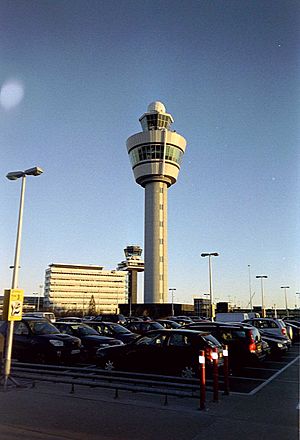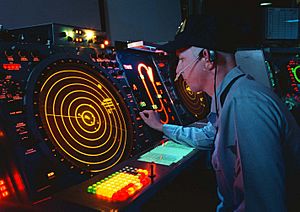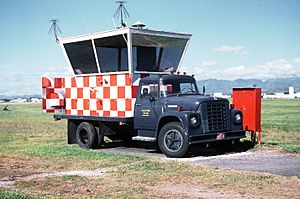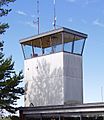Air traffic control facts for kids
Air traffic control (ATC) is a service provided by ground-based air traffic controllers who direct aircraft on the ground and through controlled airspace, and can provide advisory services to aircraft in non-controlled airspace. The primary purpose of ATC worldwide is to prevent collisions, organize the flow of air traffic, and provide information and other support for pilots. In some countries, ATC plays a security or defensive role, or is operated by the military.
Air traffic controllers monitor the location of aircraft in their assigned airspace by radar and communicate with the pilots by radio. To prevent collisions, ATC enforces traffic separation rules, which ensure each aircraft maintains a minimum amount of empty space around it at all times.
In many countries, ATC provides services to all private, military, and commercial aircraft operating within its airspace. Depending on the type of flight and the class of airspace, ATC may issue instructions that pilots are required to obey, or advisories (known as flight information in some countries) that pilots may, at their discretion, disregard.
The pilot in command is the final authority for the safe operation of the aircraft and may, in an emergency, change from ATC instructions to the extent required to maintain safe operation of their aircraft.
Areas for ATC
- "Ground Control" is responsible for all aircraft and vehicles on all taxiways, inactive runways, holding areas and aprons.
- "Clearance Delivery" is the position that issues route clearances to aircraft. This is important for safe flying via planned route. Clearance Delivery has to cooperate with the Ground Control and the Area Control centre.
- "Tower Control" gives clearance to arriving and departing aircraft. All aircraft on runways and airfield traffic circuit are directed by Tower Control too.
- "Approach Control" is responsible for airplanes in airspace near airport. There is big density of airplanes. That is reason why approach is the most difficult job in compare to another ATC service.
- "Area Control Centre" separates airplanes in controlled airspace between airports.
Airport traffic control tower
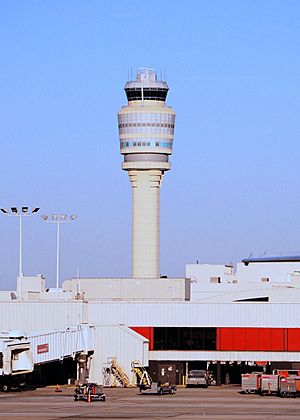
The primary method of controlling the immediate airport environment is visual observation from the airport control tower. The tower is a tall, windowed structure located on the airport grounds. Air traffic controllers are responsible for the separation and efficient movement of aircraft and vehicles operating on the taxiways and runways of the airport itself, and aircraft in the air near the airport, generally 5 to 10 nautical miles (9 to 18 km) depending on the airport procedures.
Surveillance displays are also available to controllers at larger airports to assist with controlling air traffic. Controllers may use a radar system called secondary surveillance radar for airborne traffic approaching and departing. These displays include a map of the area, the position of various aircraft, and data tags that include aircraft identification, speed, altitude, and other information described in local procedures. In bad weather conditions the tower controllers may also use surface movement radar (SMR), surface movement guidance and control systems (SMGCS) or advanced SMGCS to control traffic on the manoeuvring area (taxiways and runway).
The areas of responsibility for tower controllers fall into three general operational disciplines: local control or air control, ground control, and flight data / clearance delivery—other categories, such as Apron control or ground movement planner, may exist at extremely busy airports. Remote and virtual tower (RVT) is a system based on air traffic controllers being located somewhere other than at the local airport tower and still able to provide air traffic control services. Displays for the air traffic controllers may be live video, synthetic images based on surveillance sensor data, or both.
Air control (known to pilots as "tower" or "tower control") is responsible for the active runway surfaces. Air control clears aircraft for takeoff or landing, ensuring that prescribed runway separation will exist at all times. If the air controller detects any unsafe conditions, a landing aircraft may be instructed to "go-around" and be re-sequenced into the landing pattern. This re-sequencing will depend on the type of flight and may be handled by the air controller, approach or terminal area controller.
Within the tower, a highly disciplined communications process between air control and ground control is an absolute necessity. Air control must ensure that ground control is aware of any operations that will impact the taxiways, and work with the approach radar controllers to create "gaps" in the arrival traffic to allow taxiing traffic to cross runways and to allow departing aircraft to take off. Ground control need to keep the air controllers aware of the traffic flow towards their runways in order to maximise runway utilisation through effective approach spacing.
Images for kids
-
São Paulo–Guarulhos International Airport's control tower
-
Control tower at Birmingham Airport, England
-
Inside Pope Field air traffic control tower
-
Potomac Consolidated TRACON in Warrenton, Virginia, United States
-
The training department at the Washington Air Route Traffic Control Center, Leesburg, Virginia, United States
-
Intersecting contrails of aircraft over London, an area of high air traffic
-
Airplane taking off from Dallas/Fort Worth International Airport with the ATC tower in the background
See also
 In Spanish: Control del tráfico aéreo para niños
In Spanish: Control del tráfico aéreo para niños


